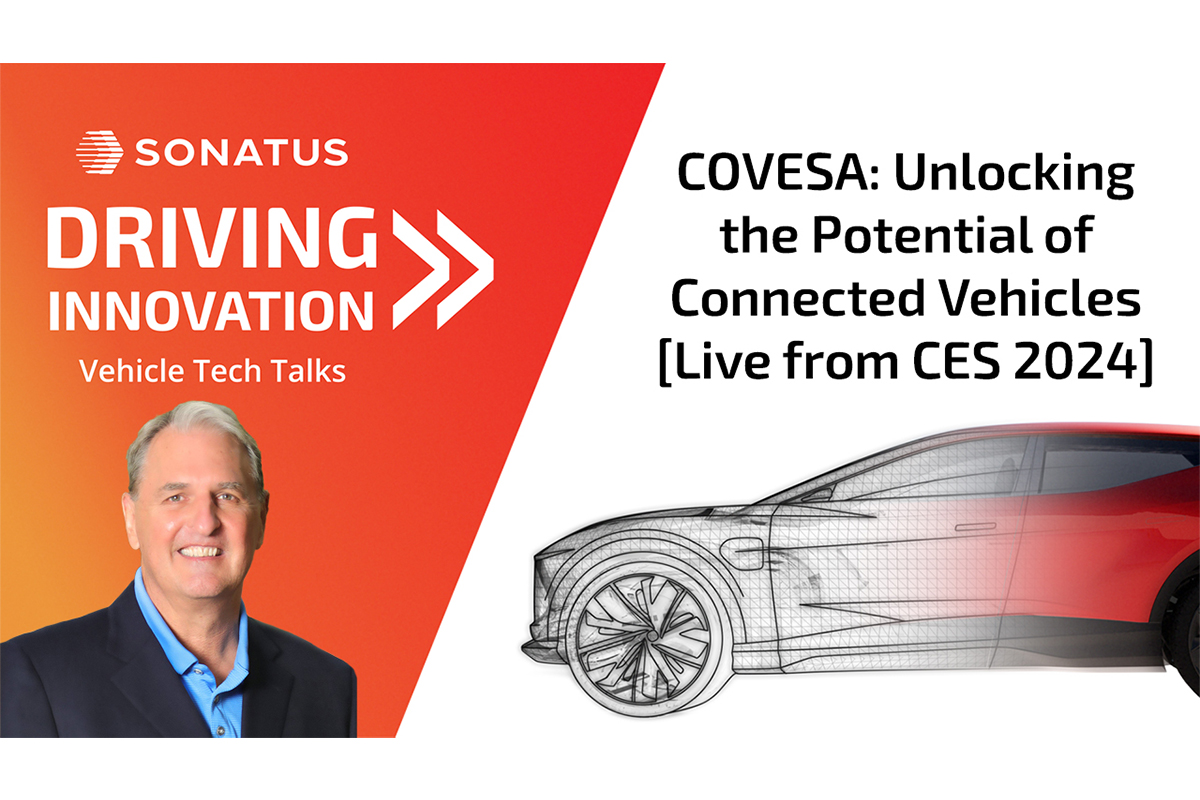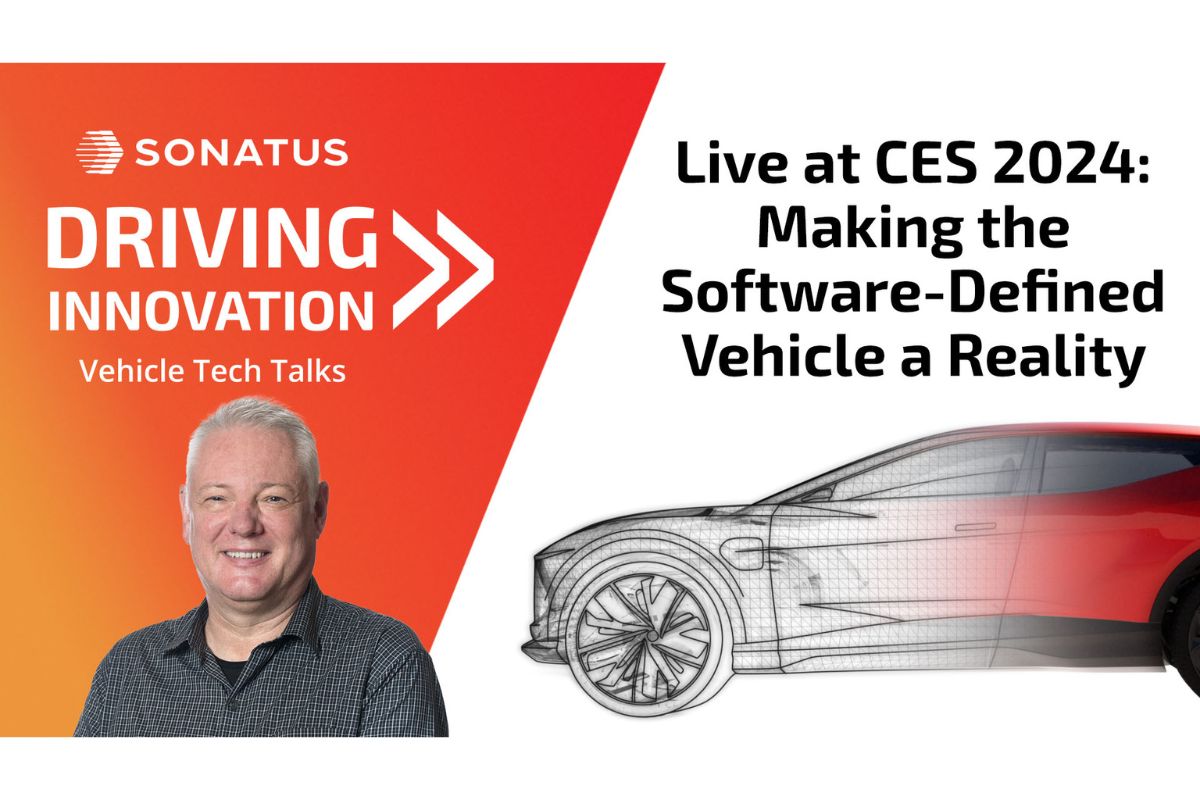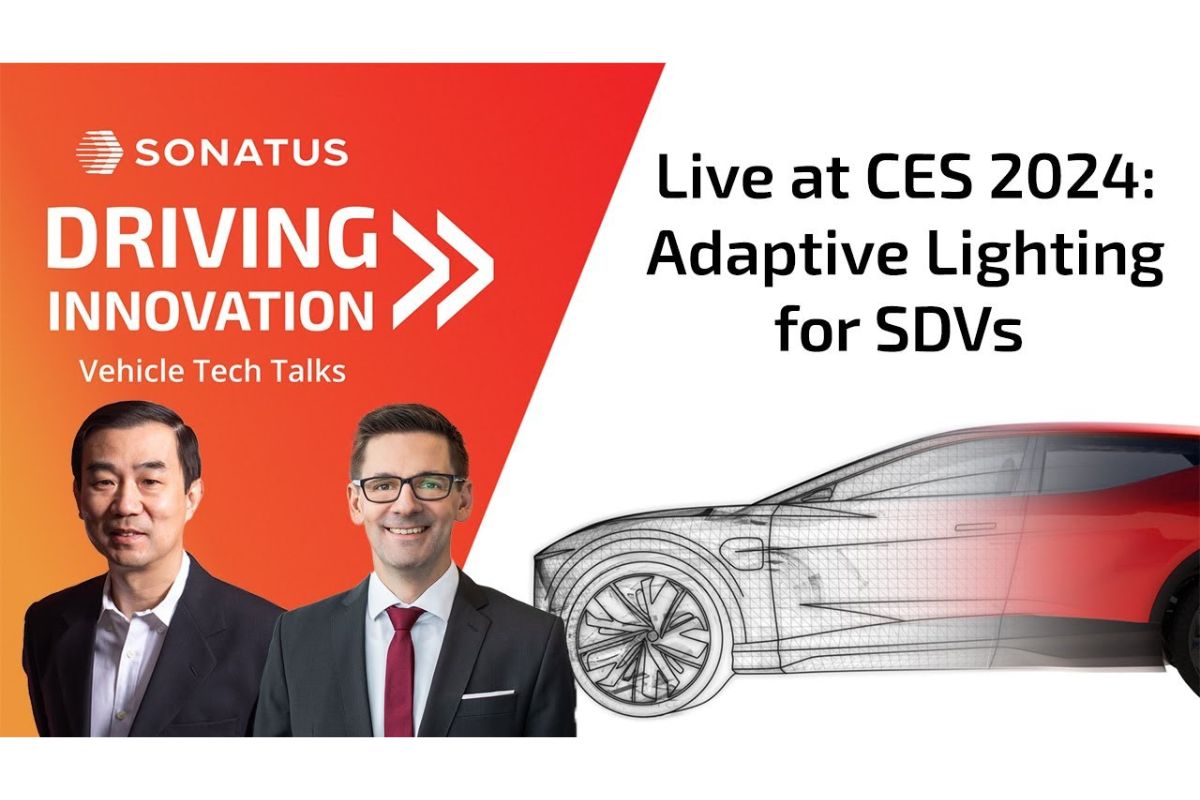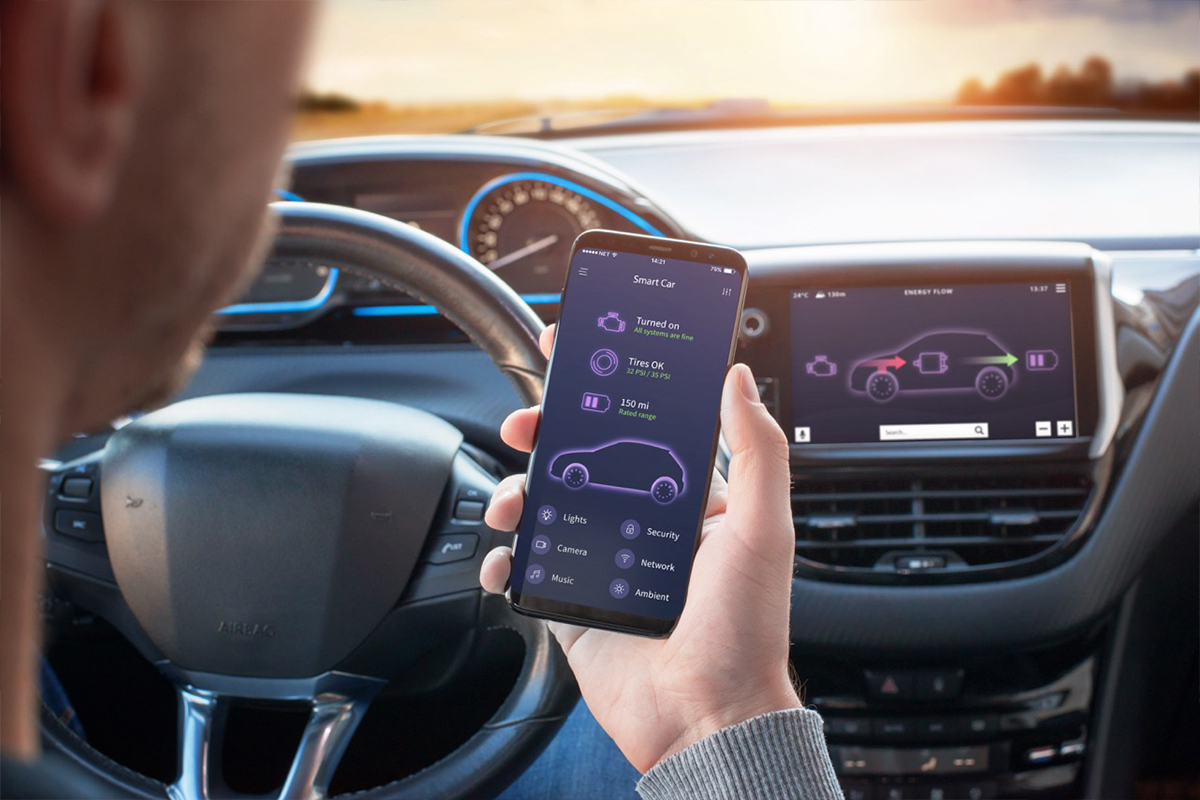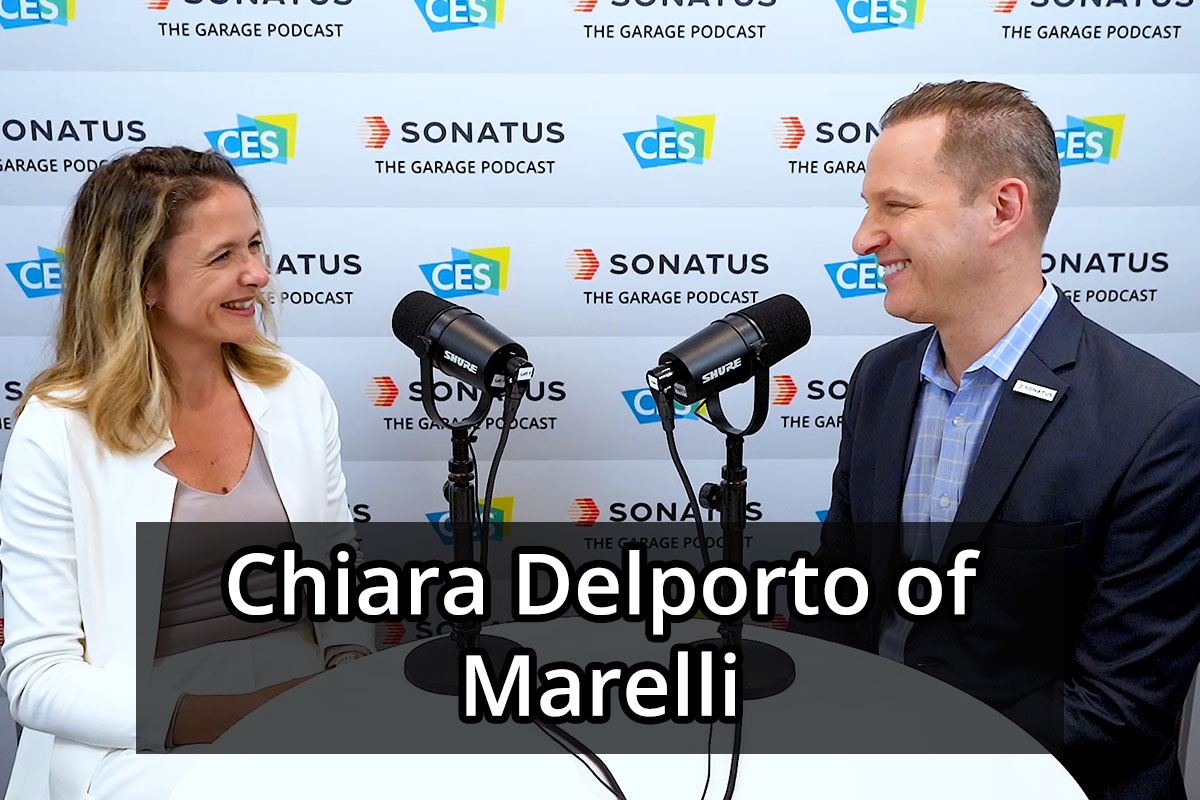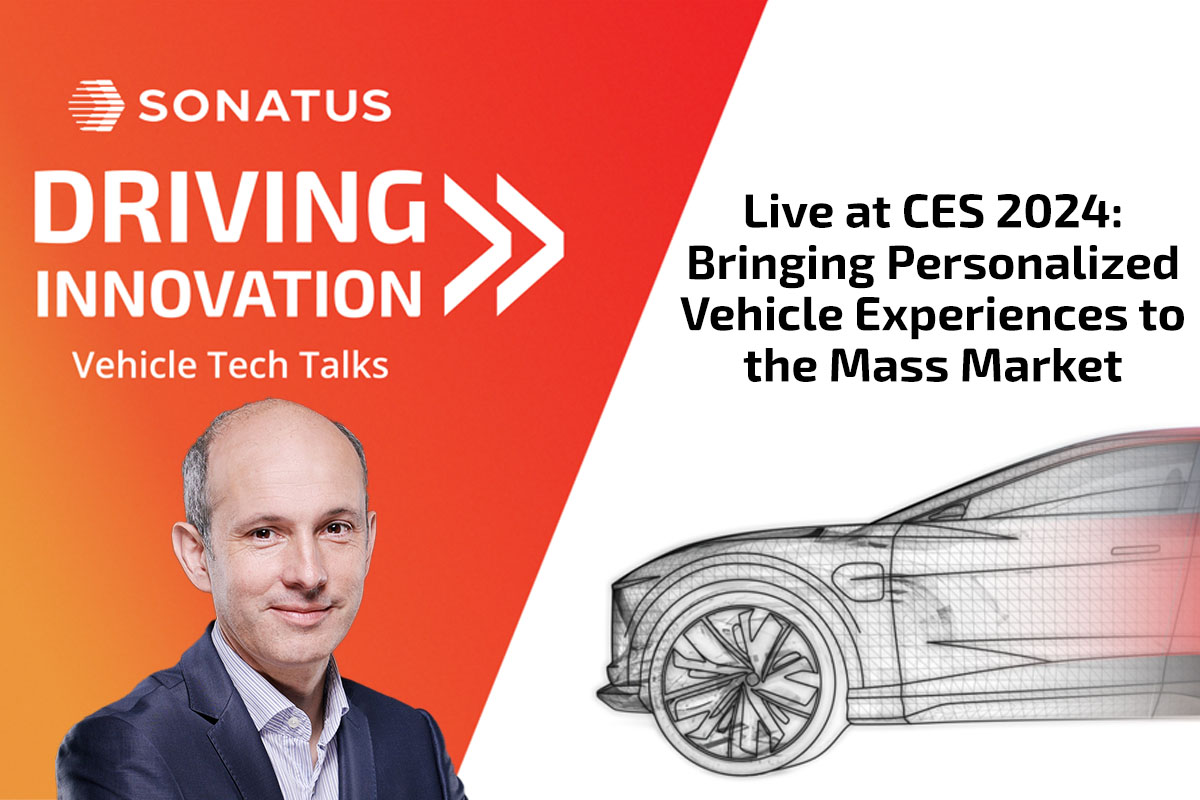Overview
SANJAY: Well, thanks for joining us here at the CES 2024 floor. We’re in the Sonatus booth, and today we’re going to be talking about vehicle personalization with my friend and colleague Eric from Marelli. Hello, Eric.
ERIC: Hello, Sanjay. I’m Eric Monjalon. I’m Product Manager for Integrated Cockpit, Telematics & SDV at Marelli.
SANJAY: Welcome, Eric. We really are happy about the collaboration that we’ve had with Morelli. My name is Sanjay Khatri. I’m the Head of Product Marketing here at Sonatus.
Agenda
SANJAY: So software-defined vehicles are expected to allow OEMs to deliver personalized vehicle experiences to their customers. And we’re going to talk a little bit about that, and particularly how Marelli is enabling that, and how our partnership between Marelli and Sonatus is taking that even further, and what we’re showing here at Sonatus’ booth in CES 2024 as well. So let’s just get started.
Key SDV features for vehicle personalization
SANJAY: So how do SDVs enable OEMs to deliver personalized vehicle experiences? So there are some key factors when we talk about SDVs that allow these sorts of tailored experiences to be delivered to end consumers. So first of all, as we move toward software-defined vehicles, the architectures are also becoming more centralized, which means that you can create more holistic experiences, multi-domain experiences in the vehicle, not just a single feature, but a vehicle-wide set of features. The other thing that is enabling vehicle personalization is the increasing amount of digitalization in the vehicle. So we’re talking about digital functions. A lot of the functions in the vehicle are digital, which means they’re software controllable, and that also means that they’re dynamically configurable. And then finally, SDVs are also about connectivity, connectivity of the vehicle to the cloud, which allows then, the vehicles to be continuously monitored as well as updated for new features and experiences and new personas and new tailored experiences that are delivered to end customers.
Overview of Marelli products
SANJAY: So let me shift now to Marelli, and let Eric talk about what Marelli is doing to enable these personalized experiences in the vehicle. Eric?
ERIC: Yeah, thank you, Sanjay. So here you can see all the products that Marelli is having in its fifth-generation electrical architecture. You have a digital cockpit, you have zonal and telematic that connect the car to the cloud. We also have a bunch of displays that are used to reflect what the personalization or how the personalization is made for the end user. For the driver. Like with the 3D display that is showing an avatar that is changing according to your mood, according to your profile. We have a bunch of services in the cloud and also a framework that is allowing this service to interact with the product in the car.
Digital Cockpit Domain Controller
ERIC: Here I would like to make a small focus on our main product. That is the Cockpit Domain Controller in the sense that it is the core of the vehicle. It’s the brain where all the decisions are taken and sent to the zonal ECUs. Our Cockpit Domain Controller is composed of an instrument cluster and an infotainment system, both together in the same ECU. That allows you to run different software in different areas such as driving display with media rendering, or having artificial intelligence running on the car, and of course having different applications like a driver monitoring system, and occupant monitoring system, that are usually in different ECUs. But now we can integrate everything in one single central control unit.
Personalization follows end-users across vehicles
ERIC: Here, I can explain how we use this infrastructure, this hardware architecture to enable software-defined personalization. We use different functionality of the zonal to interface between different parts in the car. A knob, for example, can be allocated to different functions, even if these functions are not located in the same zone where the knob is. That allows us to command the audio, the seats, with a single button, for example. So we can see how this works. We can have different applications on the smartphone or on the web. We use the Marelli Digital Studio. When you configure your profile for the first time, you can configure which action you want to allocate to a knob or which action you want to perform as soon as you enter your car. And this is saved in your profile and you can use it in the car. The best point of that is that it’s not a software configuration of your car, but it’s linked to your persona, to your person. This means that if you want to change a car, or rent a car, you retrieve exactly the same parameter and your car will behave exactly as you expect. An example, if you configure your seat just for your best driving position and if you go to another car of another brand, you want to retrieve exactly the same best driving position, whatever is the relative position of the seat in the car. So this is really linked to the persona and not linked to the car configuration itself.
Marelli and Sonatus collaboration
SANJAY: Great. So with the capabilities that Marelli provides in the cabin with their Cockpit Domain Controller, as well as all of the other pieces that allow the vehicle to be more configurable, we can then add the Sonatus products on top of that to add another layer of personalization. So what we’ve done with Marelli at CES 2024 is to use their Cockpit Domain Controller, their software configurable Cockpit Domain Controller, and added the Sonatus Automator product on top of that. So what Sonatus Automator does is it allows OEMs to create these feature routine templates. So think of this as if-this-then-that. If a vehicle is traveling at a certain speed, then change the seat position to something else. Or if the temperature outside is a certain temperature, then change the HVAC settings, or change the mood lighting. All of these sorts of things can be done with Sonatus Automator added on top of the infrastructure that Marelli provides. So in this case, once the OEMs create these feature routines, they can publish these routines in end user-facing apps. So these could be apps for the web interface, it could be apps for the in-vehicle infotainment, or it could be an app on a smartphone. With that, the consumers can then take those templates and further personalize it to create their own vehicle features and experiences. Once those routines are deployed, the Marelli Cockpit Domain Controller then executes those routines to create those personalized experiences. So the personalized experience could be, how do I want the vehicle to be configured for my commute mode versus when I’m going on a road trip? How do I want it to integrate with my smart home? How do I want it to restrict my teen driver since my teenage child will be sharing that car? So you can do all of these personalized settings using this Automator product to create these “if-this-then-that” types of routines. So the summary of this is that with the flexibility that Marelli provides with all of their in-cabin, in-vehicle products and solutions combined with Automator’s flexibility in creating these personalized routines, you can really, truly create a personalized vehicle experience.
What’s next for Marelli in vehicle personalization
SANJAY: So that brings us to the end of our presentation. I’d like to spend a few minutes talking with Eric about what’s next for both of our companies in this area of vehicle personalization. So Eric, can you give us a little bit more background or information around what Marelli is doing in the field of SDVs to bring this type of personalization to the mass market?
ERIC: Yeah, sure, there are different axes. The first one is to continue to invest on the fifth-generation architecture by improving and modifying our zonal that needs to be fit for the future by receiving the microservices. You know that we have implemented already microservices in the Digital Cockpit, but we need to have the same approach on zonal to be able to move the service from one zonal to another one without being obliged to recopile if we want to change the micro or whatever. So this is huge work that we are doing right now in order to be even more flexible in the future. The other point is the development of the digital twin. We have presented at CES 24, a digital twin for the integrated cockpit, which is running a cluster and an IVI in the cloud. Even now you can see HMI running in the cloud, like in a game. Yeah, it’s already interesting, but we want to go further, deeper in this digitalization with different levels of abstraction of the hardware. Because the game is to have less hardware and more software for the development.
SANJAY: Sure.
ERIC: What is missing for us is yet, the zonal. We have just a small prototyping of the digital twin of the zonal, but we need to go further, more in development with our silicon vendor because the models are not yet ready. So this is really what we see for the future. And then the next step is to use all this infrastructure. This new feature that we have implemented with microservices, zonal, cockpit- to collect all the information coming from the car and to understand better what the driver is doing in his everyday life. Like that, we can collect and re-engineer or rethink how the interface should fit better with the personalization. If the driver every morning arrives and opens the window, for example, we need to be able to analyze that and to propose an automation to do this kind of stuff. Those are the bricks that we need to explore to improve our personalization.
SANJAY: Sure.
ERIC: But I think you already have some exploration also on your side for this personalization.
What’s next for Sonatus in vehicle personalization
SANJAY: Yeah, absolutely. As I mentioned, we’re already collaborating, using the flexibility of your Domain Controller and all of the other pieces of your architecture and product set to bring these personalized routines in the vehicle. The next step for Sonatus is that, how do you make sure that these types of routines are intelligently applied into the vehicle? Right? So rather than the customers themselves having to configure it, can we make it possible that the consumer’s preferences are understood, analyzed, and these personalization routines are automatically suggested so that the customer doesn’t even have to think about it? So we have a collector product which allows you to do very fine-grained data collection around user preferences and behavior. As you mentioned, what happens when the vehicle- when the passenger or the driver comes into the vehicle? What do you want the vehicle to do? Observe those things and then analyze them in the cloud and then come up with a suggested routine that the user can then further personalize without actually having to think about creating the routine itself.
ERIC: Yeah, that’s great. That’s exactly what we need to do also for the HMI, you know, proposing some different HMI to the driver.
SANJAY: Yes.
ERIC: Because you always have your habit and using always the same touch button. So why go into a subset, subset button if you can get it immediately when you arrive in the car.
SANJAY: Yeah.
ERIC: So this kind of information is also very interesting for us, and we’ve started to collect some information now we need to really focus for each single user and propose a customized HMI. That’s also a great improvement.
SANJAY: Yeah.
ERIC: Yeah.
Wrap up
SANJAY: So great. Thank you Eric again we really appreciate Marelli’s partnership in this and we think that this holds a lot of promise in the future to really bring sort of tailored, customized vehicle experiences to the individual consumer that we think that is going to be available pretty soon in the mass market.
ERIC: Yeah. Thank you, Sanjay, for improving also our personalization and helping us also to enable this dream to have the car personalized around the user. It’s a user-centric experience and not only centered in the car.
SANJAY: So that wraps it up for this presentation. Again, thank you for attending and viewing this presentation. We hope you enjoy the rest of the CES 2024.
